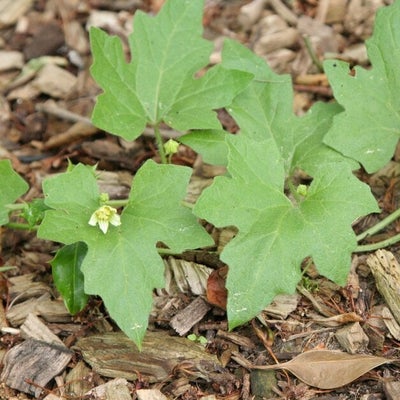
Quick facts
White bryony’s botanical name is Bryonia dioica
Black bryony’s botanical name is Dioscorea communis; it has the synonym Tamus communis
Both are native to Britain
Although once used for medicinal purposes, both plants are poisonous
Bees pollinate the flowers and birds eat the berries
If you need to control bryony, non-chemical methods are effective
What does bryony look like?
Both white and black bryony are , dying back to ground level in autumn or early winter and sending up new shoots in spring. When they are in growth, there are some notable differences in appearance between the two:
White bryony
This climbing herbaceous perennial has leaves with five lobes. Greenish-white flowers appear between May and September, followed by shiny red berries. The stems can clamber up other plants with the aid of spiralling tendrils, reaching heights of 4m (13ft). The tuberous root, initially small, increases over several years to form a large that can weigh several kilos.

Black bryony
The leaves of this climbing herbaceous perennial are heart-shaped and glossy; although usually green, they can have dark purple tints, as can the stems. Small, yellow-green flowers appear in early summer, followed by conspicuous strings of shiny, red berries that often remain throughout autumn. Unlike white bryony, black bryony does not produce tendrils, but stems are able to reach a height of 4m (13ft) by twining around other plants or supports. Black bryony produces deep, thick roots.

Though it is usually easy to tell these plants apart, it isn't neccessary to correctly identify which one you have if you wish to remove it from your garden, as the control methods are the same.
Top Tip
Wear gloves when handling white bryony, as it can cause skin irritation.
Are white bryony and black bryony weeds?
White bryony and black bryony are plants found at woodland margins and along hedgerows. They are valuable wildlife plants – bees pollinate the flowers and birds eat the berries.
Bryony seed is often brought into gardens in bird droppings, frequently sprouting underneath where birds perch, such as under hedges. While some gardeners consider bryony to be a welcome addition to wilder parts of a garden, it can be considered a weed when it grows among formal hedges and where there is a risk of smaller plants being smothered.


What is a weed?
The term ‘weed’ describes a plant that is growing where it isn’t wanted. Weeds usually thrive in average garden conditions, reproducing and spreading easily. It is up to you to decide what you call a weed and what you choose to retain or remove.
Frequently asked questions about controlling bryony
Here are our answers to your most common questions about dealing with bryony:
How invasive is bryony?
Bryony doesn’t often occur in large numbers in gardens, unless they have been left untended for many years. However, when it does appear, it is often among tree roots or under hedges, making it difficult to remove. Bryony spreads by seed; these can be deposited by birds, but they can also just drop from the plant, so if you have bryony in your garden and don’t want it to spread, be sure to remove the berries before they ripen.
Do I need to get rid of bryony?
Not necessarily – allowing byrony to grow up a robust, established hedge or shrub will increase the of your garden and allow you to enjoy its attractive berries.
Bear in mind that the stems of both plants can reach 4m (13ft) in height in one growing season. As bryony plants get older, they produce more stems, the amount and weight of which can smother nearby plants. So, if bryony appears near to cultivated borders, or small or young hedges, then it would be best to remove it.
As both types of bryony are poisonous, you may also wish to get rid of it if there is a risk that children or pets might eat some.
What is the easiest way to kill bryony?
If you have bryony growing where it isn’t wanted, there are a couple of methods of control:
- Fork out – in their first growing season, the tuberous roots of bryony are small and the whole root can be lifted out easily with a hand fork or trowel. Position your fork or trowel at the base of the stems to minimise soil disturbance. If you’ve had a mature bryony plant in your garden that produced berries, keep a look out for emerging seedlings.
- Dig out plants – use a spade to dig out the tuberous root. This may be up to 10cm (4in) below the soil where the stems emerge from the ground. Begin removing soil from around the , using a hand trowel to excavate carefully if there are lots of roots from nearby shrubs and trees. Where possible, dig out the entire root. However, even if only some of the tuber is removed, this may be sufficient to prevent further regrowth. If it isn’t, and you see new shoots appearing, keep removing these regularly to weaken the plant.
Top Tip
Don't add bryony fruits or pieces of root or tuber to your home compost bin, as it is unlikely to get hot enough to kill them off completely. This means you could inadvertently spread bryony around your garden in the resulting compost. To be on the safe side, add these to your council green waste recycling bin instead.
Should I use weedkiller?
As bryony can be removed using non-chemical control methods, there is no need to use a weedkiller. Bryony stems grow up other plants, so it would be very difficult to apply a weedkiller to the leaves without it also touching, and damaging, those of the supporting plant.
For more advice on controlling bryony, see our guide to Weeds: non-chemical control.









